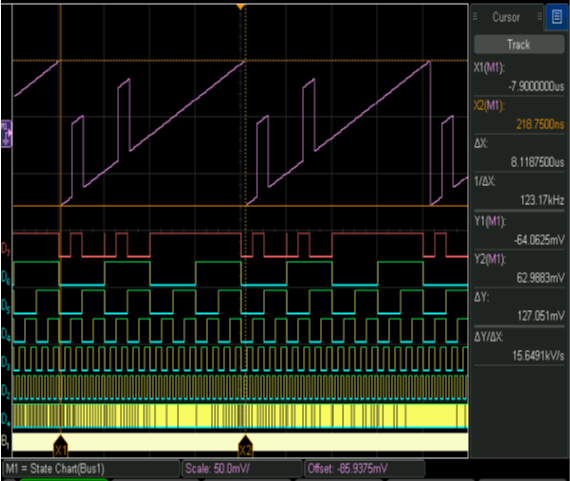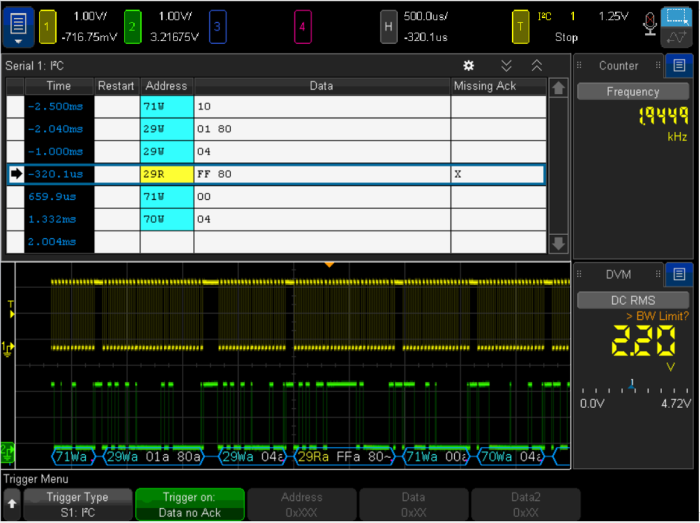As an oscilloscope user you understand the importance of analyzing analog signals in a digital circuit. However, many users are missing out on one of the most powerful features of today’s oscilloscopes: the mixed signal oscilloscope (MSO). An MSO adds up to 16 digital channels to your 4 analog channel oscilloscope. This greatly expands the types of analysis that can be performed by this versatile engineering tool. Digital signals can be a simple chip select, or a communication bus. The ability to monitor these digital signals is often critical to properly analyze system operation.
Debugging a mixed signal design can be a difficult and somewhat daunting task to the engineer who is armed with a 4-channel oscilloscope since you often need to capture more than four signals. An mixed signal oscilloscope provides that capability, with the ability to examine the state of up to 20 signals all on the same timescale, while using the familiar controls of a basic oscilloscope.
When needed, MSO digital channels provide just enough logic analysis for users whose home base is an oscilloscope. MSO digital channels serve as an extension to the oscilloscope capabilities and can provide valuable insight into the operation of your design.

Correlation of input/output of ADC/DAC is simple and straightforward. An MSO adds some very powerful and useful tools for analyzing a digital bus. In this one simple view we can see the state of the analog signal, the state of each of the digital signals, the hex representation of this digital bus, and I still have all of the measurements available on the oscilloscope to evaluate the signal quality. The controls and measurements are all still based on the oscilloscope operation, making it very easy to navigate and control.
At the same time the MSO provides the means to help analyze your digital bus. The grouping of digital signals to create a “bus” with easy-to-read hex values can be used in decoding the signals, or for triggering on specific addresses or values.
MSOs and logic analyzers have fundamental architectural differences in how they acquire and display signals. MSOs exclusively use asynchronous sampling, just like an oscilloscope. For many users, this makes setting up an acquisition on digital channels simpler, because it feels like a scope.
By applying some additional logic to the digital bus you can create a visualization of the bus operation. By using one of the signals as a clock, the MSO can chart the bus “state” to display a logical representation of the digital data.

Low-Speed Serial Bus Support
Today’s designs incorporate digital communications between components and systems by using high- and low-speed serial digital communication, and microprocessor buses. Serial buses like I²C and SPI are frequently used for chip-to-chip communication, but cannot replace parallel buses for all applications. But here again, oscilloscopes add powerful troubleshooting capability by providing just enough protocol analysis.

A key difference between logic analyzers and MSOs is the latter’s ability to trigger on and decode serial buses. Low-speed serial buses are ubiquitous in electronic designs because of their ease and low cost of implementation. In fact, it is hard to find a design that does not include at least one I2C or SPI bus, or USB.
Mixed signal oscilloscopes excel at debug that includes low-speed serial buses. All good MSOs come with both triggering and decode options for serial buses. However, logic analyzers have not incorporated similar triggering and decode technology. Without protocol triggering, it’s impossible to set up the oscilloscope to trigger on specific packets. For example, you can set the MSO to trigger when an I2C read to a certain address with a certain data value happens. Alternatively, you can trigger on a certain SPI data packet or at the start of USB enumeration.
Since the blending of analog and digital information is so prevalent, oscilloscope users can take advantage of the ability of current MSOs to improve their troubleshooting capabilities and simplify their mixed-signal design debugging.
Keysight oscilloscopes have the added benefit that most existing DSOs (Digital Storage Oscilloscope) can be easily upgraded to add MSO capabilities.
If you are reading this before September 30th 2016 and you are in the market for a new oscilloscope, you can take advantage of Keysight’s MSO promotion. You can add MSO capabilities to a new 3000T, 4000, and 6000 X-Series oscilloscope for no additional charge!
